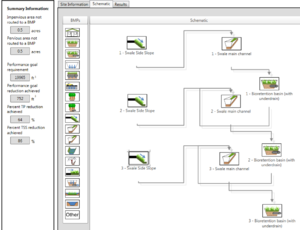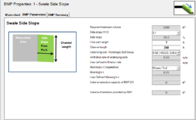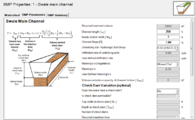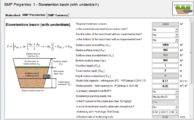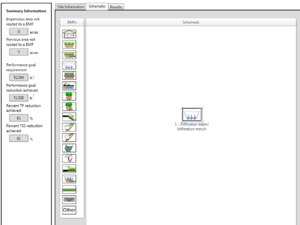
Using the Minnesota Stormwater Manual and MIDS Calculator to help meet industrial stormwater permit requirements
At permitted industrial stormwater facilities, failure to meet permit benchmark values requires implementation of management practices that reduce the concentration of pollutants in runoff. the Minnesota Stormwater Manual and Minimal Impacts Design Standards (MIDS) calculator can be used to help select, design, construct, and maintain appropriate practices and quantify pollutant reductions associated with those practices.
Contents
Using the Minnesota Stormwater Manual
The Stormwater Manual contains considerable additional information useful for selecting, designing, constructing and maintaining stormwater BMPs. The following web pages may be useful in managing stormwater at your site.
- Process for selecting Best Management Practices: This page provides a general overview of BMP options and how to select the most appropriate BMPs.
- Using the treatment train approach to BMP selection: this page provides information on combining multiple treatment practices.
- BMP design: This page contains links to the design sections for several BMPs. For example, clicking on the link for Design criteria for permeable pavement takes you to a page that describes how to properly design a permeable pavement system.
- BMP construction: This page contains links to the guidance on how to construct several BMPs. For example, clicking on the link Construction specifications for permeable pavement takes you to a page that describes how to properly construct a permeable pavement system.
- BMP operation and maintenance: This page contains links to the operation and maintenance sections for several BMPs. For example, clicking on the link for Operation and maintenance of permeable pavement takes you to a page that describes how to properly operate and maintain a permeable pavement system.
Using the MIDS calculator
The MIDS calculator estimates reductions in stormwater volume, total suspended solids, and phosphorus associated with implementation of stormwater Best Management Practices. The screen shot of the calculator below shows a site where several BMPs are used together to achieve a reduction in runoff and pollutant loads. The user must know the soil type, the facility’s zip code, and the acres of impervious and pervious surfaces being treated. A user-friendly interface allows for easy BMP selection. Inputs for each BMP vary, but the calculator can be used to properly determine the size of the BMP(s). The calculator displays results in terms of pounds of pollutant removed or percentage of pollutant removed.
Although the calculator is fairly intuitive and easy to use, the Minnesota Stormwater Manual contains detailed descriptions for the calculator, including several sample exercises. Check out these links to help you use the manual:
- Links to Manual pages that address the MIDS calculator
- MIDS calculator sample exercises
- Download the MIDS calculator (click on the zip file that starts with: "MIDSCalculator")
Example applications of the MIDS calculator and Minnesota Stormwater Manual
Below are two relatively simple example applications for the MIDS calculator. Within the MIDS Calculator, you’ll note a “Help” button in the MIDS calculator. Clicking on that button will take users to the Minnesota Stormwater Manual page that describes the specific BMP chosen for treatment. The manual page includes a description of the BMP in the calculator, examples from the calculator, and links to information on how to design, construct and maintain a bioretention basin.
MIDS calculator example 1
A 10 acre facility contains 5 acres of turf and 5 acres of impervious surfaces or compacted soils. Results from several rounds of sampling show that concentrations of total suspended solids (TSS) are 200 mg/L, which exceeds the benchmark of 100 mg/L. Soils consist mostly of clay (Soil Group D). To meet the benchmark concentration of 100 mg/L, TSS loading will have to be reduced by 50 percent or more.
Because D soils do not infiltrate well, infiltration BMPs are not an option for the site. Instead, BMPs that filter or settle the runoff must be selected. Examples include
- filtering BMPs, such as sand filters, swales, bioretention (rain garden) with an underdrain; and
- settling BMPs, such as a constructed stormwater pond.
Three bioretention BMPs (rain gardens) are used to meet the desired reduction. The bioretention BMPs are connected by a grass swale. For simplicity, each bioretention basin, swale, and side slope to each swale are the same dimensions. the schematic to the right show the treatment system. Screen shots from the calculator BMPs are shown below. Inputs for each BMP are summarized below. Note that in this example all the runoff from pervious and impervious surfaces is routed to the swale side slopes (1.5 acres to each of the 3 side slopes). Side slope lengths match the main channel lengths. Only one side slope is included in the treatment scheme since side slopes have little effect on pollutant reductions. TSS loading is 2128 pounds. The BMPs retain 1823.3 pounds. Of this total, 1417 pounds are retained in the swale, which represents a 67 percent reduction in TSS loading. So the swales by themselves achieve more than the required 50 percent reduction in TSS loading.
- Bioretention basin inputs
- Not elevated above native soils
- Not lined
- Surface area at overflow = 1000 ft2
- Media surface area = 900 ft2
- Bottom surface area = 900 ft2
- Overflow depth = 1 ft
- Total media depth = 2 feet
- Media field capacity = 0.11 ft3/ft3
- Media porosity = 0.25 ft3/ft3
- No trees
- Media Mix D
- No soil amendment
- Hydrologic Soil Group D
- Drawdown time = 48 hours
- Swale main channel inputs
- Channel length = 250 feet
- Swale bottom width = 7 ft
- Channel slope = 1%
- Hydrologic Soil Group D
- Manning's n - mowed turf
- No check dams
- No bioretention base
- Swale side slope
- Side slope= 5:1
- Flow path length = 7 ft
- Channel length = 250 ft
- Hydrologic Soil Group D
- Manning's n - mowed turf
- MIDS calculator screen shots for inputs for Example 1.
MIDS calculator Example 2
Assume the same site as for Example 1 except that the site is on Hydrologic Soil Group A soils with an infiltration rate of 1.63 inches per hour. This is an ideal soil for infiltration. The Industrial Stormwater permit, Appendix A, provides a waiver for benchmark monitoring if an infiltration practice can capture the 2 year, 24-hour storm. For this site that is 2.83 inches. This value is typed in as the performance goal in the MIDS calculator. To achieve this volume of infiltration, the following infiltration basin can be constructed.
- Surface area at outflow = 10000 ft2
- Media surface area = 10000 ft2
- Overflow depth = 5.13 ft
- Drawdown time = 48 hours
This system achieves an 81 percent reduction in runoff volume, total phosphorus loading, and TSS loading. This is well beyond the required reduction of 50 percent for TSS, but the sizing is necessary to meet the waiver requirement of meeting the 2 year, 24-hour precipitation event. The MIDS calculator can be used to size the BMP by allowing the user to adjust the BMP area and depth. For this example, a smaller BMP could be utilized by making the BMP deeper. Since water must drain within 48 hours the maximum depth would be 6.5 feet. This would allow the surface area of the BMP to be reduced by 20 percent to 8000 square feet.
This page was last edited on 5 December 2022, at 15:57.
